
Blitum bonus-henricus, also called Good-King-Henry, poor-man's asparagus, perennial goosefoot, Lincolnshire spinach, Markery, English mercury, or mercury goosefoot, is a species of goosefoot which is native to much of central and southern Europe.
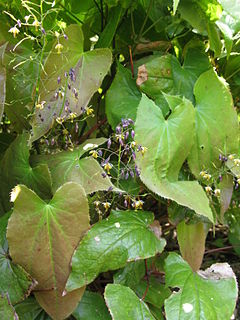
Epimedium sagittatum is a flowering plant in the barberry family (Berberidaceae) native to China. It is known locally as 三枝九叶草 and is sometimes called horny goat weed for its purported aphrodisiac properties.

Cynodon is a genus of plants in the grass family. It is native to warm temperate to tropical regions of the Old World, as well as being cultivated and naturalized in the New World and on many oceanic islands.
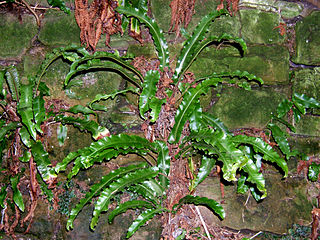
Asplenium scolopendrium, known as hart's-tongue or hart's-tongue fern is an evergreen fern in the genus Asplenium, of the Northern Hemisphere.

Yanachaga–Chemillén National Park is a protected area located in the region of Pasco, Peru. It preserves part of the rainforests and cloud forests of central Peru.

Gynerium is a monotypic genus of Neotropical plants in the grass family, native to Mexico and Colombia, Central America, South America, and the West Indies. It is classified in its own tribe Gynerieae.
The sombrero vueltiao is a traditional hat from Colombia and one of its symbols. It is made out of Gynerium sagittatum known locally as caña flecha, a type of cane that grows in the region. The word vueltiao is a Colombian regionalism from the northern Caribbean Region and the area surrounding the Magdalena River basin that originate in the word for "turn" or "lap", and arose due to the way the hat is made. The quality of the hat is determined by the number of pairs of fibers braided together to make the hat, and its bending flexibility. The more flexible the hat is, the higher quality it is.

Centrosema, the butterfly peas, is a genus of American vines in the legume family (Fabaceae). Species include:

Nanorrhinum is a genus of flowering plant in family Plantaginaceae.
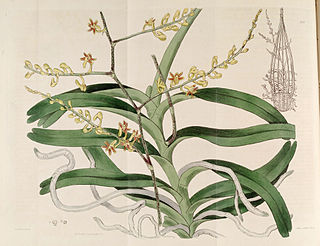
Cleisostoma is a genus of orchids with approximately 90 accepted species widely distributed through much of the Indian Subcontinent, Southeast Asia, China, New Guinea, and some of the islands of the Western Pacific.
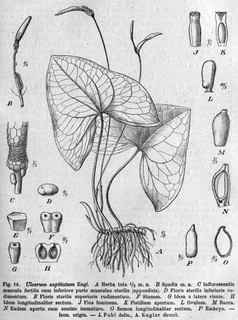
Ulearum sagittatum is a species in the family Araceae. It is endemic to western Brazil and Peru.

Ulearum is a genus of flowering plants in the family Araceae. It contains two known species, both native to South America. Ulearum is similar to Callopsis, but Callopsis is found only in Africa and so its relation is uncertain.
- Ulearum donburnsiiCroat & Feuerst. 2003 - Ecuador
- Ulearum sagittatumEngl. 1905 - Loreto region of eastern Peru, Acre State in western Brazil

Cyclophyllum is a genus of flowering plants in the family Rubiaceae. It is found from New Guinea, Australia and on islands in many parts of the Pacific.
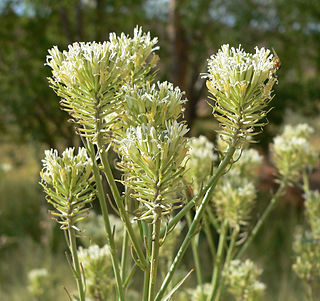
Thelypodium is a genus of flowering plants in the mustard family. There are 16 to 20 species, all native to western North America. Thelypody is a common name for plants in this genus.

Pontia beckerii, the Becker's white, Great Basin white, or sagebrush white, is a butterfly in the family Pieridae. It is found in western North America from Baja California, Mexico to southern British Columbia, Canada.
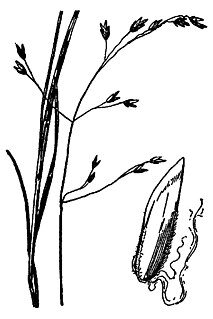
Poa paludigena is a species of grass known by the common names bog bluegrass, marsh bluegrass, slender marsh bluegrass, and Patterson's bluegrass. It is native to the northeastern United States.

Persicaria sagittata, common names American tearthumb, arrowleaf tearthumb, or arrowvine, is a plant species widespread in the eastern half of North America as well as in eastern Asia. It has been found in every state and province from Texas to Manitoba to Newfoundland to Florida, plus Colorado and Oregon. It also grows in China, the Russian Far East, Siberia, Korea, Japan, northern India and Mongolia. It grows in moist areas along lake shores, stream banks, etc.
Chromolaena sagittata is a Mexican species of flowering shrub in the sunflower family. It is found in western Mexico, in the states of Sonora, Sinaloa, Nayarit, and Baja California Sur.

Microloma sagittatum, the bokhoring, is a species of plant in the family Apocynaceae, that is native to the south-western Cape, South Africa.

Cheilosporum is a genus of red algae in the family Corallinaceae.
















